
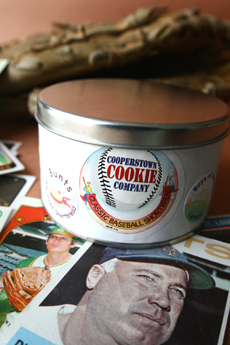
Baseball cookies for baseball season! We love these classic shortbread cookies from the Cooperstown Cookie Company. Read our full review and order some for your favorite baseball fans. Photo by B.A. Van Sise.

|
 |

June 2007 Gourmet News & Views
Trends, Products & Items Of Note In The World Of Specialty Foods
Gourmet News is published by 11 a.m. each Monday.
To send news releases, see below.
- Click here for the news archives.
- You can receive the news via RSS by clicking on the RSS box above.
- You also can receive a weekly e-mail with links to this page by subscribing to the News Feed.
6.25.07
News
Camembert Controversy. Two of France’s largest Camembert producers, Lactalis and the Isigny Sainte-Mère cooperative (which together made 90% of the traditional raw milk Camembert in Normandy), began earlier this year to treat most of the milk used for their traditional raw milk Camembert cheese. As a result, both companies 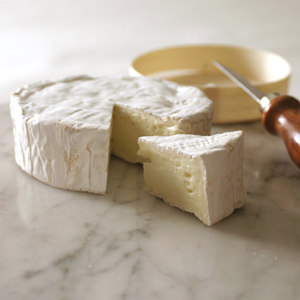 could no longer boast the “Appellation d’Origine Contrôlée” or “A.O.C.,” an official (and highly-coveted) certification that authenticates the content, origin and method of production of a French agricultural item. As a result, both companies lost their A.O.C. status, but are petitioning for its return. They claim that treating the milk—by either filtering or gently heating it—does not diminish the taste nor the quality of the cheese, and therefore they should still be granted A.O.C. status, claiming that they switched processes due to health concerns (there are occasional cases of illness and rare instances of death from the bacteria in raw milk cheese). Some would beg to differ, including the recently-formed Committee for the Defense of Authentic Camembert, a small lobbying group created to defend the use of raw milk when creating Camembert cheese. It claims that the move is a ploy by the dairy giants to make more cheese and more profit while destroying a part of French gastronomic heritage. If the companies’ petition is granted, they argue, raw milk cheese would be threatened. Out of the 112,000 tons of Camembert produced in France, only 12,000 of those tons (made from raw milk from Normandy) were granted A.O.C. status. Cheesemakers and connoisseurs prefer raw milk because the heat that destroys potentially harmful bacteria also destroys beneficial bacteria that add delicate flavor to the cheese. The raw milk vs. pasteurized milk debate exists in the U.S. as well. The USDA is extremely protective of U.S. citizens, prohibiting the sale of raw milk cheeses until they have been aged for at least 60 days, by which time any harmful bacteria will have expired. Read our article on the great raw milk cheese debate for more information. Camembert photo courtesy of CaviarRusse.com. could no longer boast the “Appellation d’Origine Contrôlée” or “A.O.C.,” an official (and highly-coveted) certification that authenticates the content, origin and method of production of a French agricultural item. As a result, both companies lost their A.O.C. status, but are petitioning for its return. They claim that treating the milk—by either filtering or gently heating it—does not diminish the taste nor the quality of the cheese, and therefore they should still be granted A.O.C. status, claiming that they switched processes due to health concerns (there are occasional cases of illness and rare instances of death from the bacteria in raw milk cheese). Some would beg to differ, including the recently-formed Committee for the Defense of Authentic Camembert, a small lobbying group created to defend the use of raw milk when creating Camembert cheese. It claims that the move is a ploy by the dairy giants to make more cheese and more profit while destroying a part of French gastronomic heritage. If the companies’ petition is granted, they argue, raw milk cheese would be threatened. Out of the 112,000 tons of Camembert produced in France, only 12,000 of those tons (made from raw milk from Normandy) were granted A.O.C. status. Cheesemakers and connoisseurs prefer raw milk because the heat that destroys potentially harmful bacteria also destroys beneficial bacteria that add delicate flavor to the cheese. The raw milk vs. pasteurized milk debate exists in the U.S. as well. The USDA is extremely protective of U.S. citizens, prohibiting the sale of raw milk cheeses until they have been aged for at least 60 days, by which time any harmful bacteria will have expired. Read our article on the great raw milk cheese debate for more information. Camembert photo courtesy of CaviarRusse.com.
Whole Foods-Wild Oats Merger, cont’d. In an earlier Gourmet News posting (6.11.07), we discussed the FTC challenge to the proposed Whole Foods acquisition of Wild Oats. John Mackey, CEO of Whole Foods, recently posted a blog entry to substantiate why he feels the acquisition does not violate antitrust laws by eliminating Whole Foods’ major competitor. A key assertion in the blog is that Whole Foods considers stores like Trader Joe’s and Wegman’s to be much bigger competitors. While these chains are certainly competitors, how do do you think most consumers (including Whole Foods employees who haven’t read the blog) would answer the question, “What food store chain is Whole Foods’ major competitor?” We hold no food company stocks and are neutral on the topic, but wish we had the time to conduct the survey! You can read more of the CEO’s blog on WholeFoods.com.
Product Watch
Redwood Creek Wines Hosts Campfire Classic. Redwood Creek wines announced the winners of its annual Campfire Classic—“campicurean” dishes that can be cooked 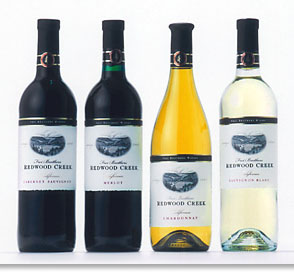 outside on a grill. The winning foods were presented at a grill-off in New York City’s Riverside Park, pairing each of the finalists with a Redwood Creek wine. Judges, including the Food Network’s Bob Blumer, tasted Chincoteague Scallops, Coal-Roasted Chuckbox Pozole-Stuffed Onions, Down East Lobster Scampi à la Campfire, Lost in the Woods Pork Tenderloin and Rocky Mountain Pinon Paella. The winner—also THE NIBBLE editors’ favorite, were the Coal-Roasted Chuckbox Pozole-Stuffed Onions, by Leah Lyon, Ada, Oklahoma. Look for the recipes on the RedwoodCreek.com website. outside on a grill. The winning foods were presented at a grill-off in New York City’s Riverside Park, pairing each of the finalists with a Redwood Creek wine. Judges, including the Food Network’s Bob Blumer, tasted Chincoteague Scallops, Coal-Roasted Chuckbox Pozole-Stuffed Onions, Down East Lobster Scampi à la Campfire, Lost in the Woods Pork Tenderloin and Rocky Mountain Pinon Paella. The winner—also THE NIBBLE editors’ favorite, were the Coal-Roasted Chuckbox Pozole-Stuffed Onions, by Leah Lyon, Ada, Oklahoma. Look for the recipes on the RedwoodCreek.com website.
Boca Loca Cachaça Comes to the U.S. Boca Loca, a company with 20-year-old roots in a small Brazilian sugar plantation, has introduced its cachaça (pronounced ca-SHA-sa) to the U.S. Cachaça, which is made from pressed sugar cane juice, is a very close relative to rum, which is distilled from sugar cane molasses. The drink is a key ingredient in caipirinhas, Brazil’s national cocktail. The handsome bottle makes a nice party gift instead of another bottle of wine.
Trends
Rosé Wine Grows in Popularity. If you want to bring wine, think of a rosé. Long popular on the French Riviera, rosé began to disappear from view in the U.S. in the 1980s, with the decline of classic French cuisine (cheese soufflé and rosé were a classic pairing). Over the past year, however, premium-priced rosé wine sales have shot up a whopping 45%, accounting for more than $9 million in sales. Twenty-eight new brands of rosé were introduced in 2006, almost double the amount in 2005. The countries of origin are diversifying as well—while popular brands still arrive from France, the U.S., Spain and South Africa are also producing fine rosés. They’re a perfect summer wine: Read our article on Red Wines For Summer for tips.

6.18.07
News
Blood Chocolate. Leonardo DiCaprio may have taught everyone about the dangers  of blood diamonds, but now there is another problem product infiltrating commercial markets: blood chocolate. According to the appropriately dubbed “Hot Chocolate” report released by U.K.-based watch group Global Witness, more than $118 million of the cocoa (cacao) trade has been used to fund both the Côte d’Ivoire government and Forces Nouvelles, the rebel group holding onto the northern part of the Côte d’Ivoire. Forty percent of the world’s cacao comes from the Ivory Coast, making the county the world’s largest supplier of chocolate. Ghana, the next largest producer, supplies only 20%. Out of a total population of 16 million, three to four million people work in the cacao industry. None of the Côte d’Ivoire cacao is fair-trade or organic. To understand this complex issue in depth, read the report, which can be downloaded from GlobalWitness.org. of blood diamonds, but now there is another problem product infiltrating commercial markets: blood chocolate. According to the appropriately dubbed “Hot Chocolate” report released by U.K.-based watch group Global Witness, more than $118 million of the cocoa (cacao) trade has been used to fund both the Côte d’Ivoire government and Forces Nouvelles, the rebel group holding onto the northern part of the Côte d’Ivoire. Forty percent of the world’s cacao comes from the Ivory Coast, making the county the world’s largest supplier of chocolate. Ghana, the next largest producer, supplies only 20%. Out of a total population of 16 million, three to four million people work in the cacao industry. None of the Côte d’Ivoire cacao is fair-trade or organic. To understand this complex issue in depth, read the report, which can be downloaded from GlobalWitness.org.
Nonorganic Organics. The Department of Agriculture is expected to approve 38 nonorganic ingredients that will be allowed to be used in products labeled as organic. These ingredients can be included in organic products since organic forms are not commercially available. For example, reports The New York Times, Annie’s Homegrown uses nonorganic annatto, a vegetable dye, to color its macaroni and cheese yellow. Other products include hops for beer, dill weed oil for pickle flavor and elderberry juice for coloring. There are three levels of organic products: 100% organic, organic (95% organic) and made with organic ingredients (at least 70% organic). See our Glossary of Organic Terms for details.
Product Watch
Tequila Takes Off. Vida Tequila has launched its ultra-premium brand tequila in 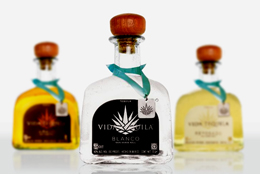 New York, Miami, and Chicago. Vida is recognized as ultra-premium due to the distillation process used to removed heads, the slightly metallic tasting compound common in other tequila brands, and tails, the final part of the distillation process that removes ethanol which often causes hangovers. Thus, only the “heart” of the blue agave, the most flavorful part of the plant, remains. Vida has three kinds of tequila available: New York, Miami, and Chicago. Vida is recognized as ultra-premium due to the distillation process used to removed heads, the slightly metallic tasting compound common in other tequila brands, and tails, the final part of the distillation process that removes ethanol which often causes hangovers. Thus, only the “heart” of the blue agave, the most flavorful part of the plant, remains. Vida has three kinds of tequila available:
- Blanco: clear and transparent, bottled immediately after distillation.
- Reposado: light yellow and translucent, aged at least six months in American oak barrels.
- Añejo: brighter yellow, aged 18 to 24 months in French oak barrels.
The blue agave itself takes 8 to 12 years to reach full maturity, so the tequila you drink has taken an awful long time to reach your tongue.
Boursin Toppers. Spreadable Boursin cheese is now available in “Topper” form, bite-size chunks (or “buttons”) perfect for salads or snacks, in Garlic & Fine Herbs or Green & Black Olives. A limited edition of Apple, Cranberry & Cinnamon will be available October to December.

6.11.07
News
Father’s Day is Sunday, June 17. While many people likely think that Father’s Day is a “Hallmark Holiday,” thanks go to Sonora (Mrs. John B.) Dodd of Washington State, 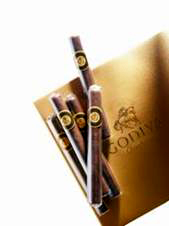 who suggested the holiday back in 1909. Her father, Civil War veteran William Smart, was a widower who raised six children. As an adult, Mrs. Dodd wanted to honor the selflessness of her father and others, and proposed June 5, her father’s birthday. However, the celebration was postponed until the third Sunday in June, to have time to prepare Father’s Day cards. From the grass roots movement in Washington, various towns and cities across America began to celebrate a Father’s Day. In 1924, President Calvin Coolidge supported the idea of a national holiday, but it didn’t become official until 1966, when President Lyndon Johnson signed a presidential proclamation that set aside the third Sunday of June as Father’s Day. Buy dad a deluxe chocolate cigar from BurdickChocolate.com, or pick one up at your nearest Godiva boutique. who suggested the holiday back in 1909. Her father, Civil War veteran William Smart, was a widower who raised six children. As an adult, Mrs. Dodd wanted to honor the selflessness of her father and others, and proposed June 5, her father’s birthday. However, the celebration was postponed until the third Sunday in June, to have time to prepare Father’s Day cards. From the grass roots movement in Washington, various towns and cities across America began to celebrate a Father’s Day. In 1924, President Calvin Coolidge supported the idea of a national holiday, but it didn’t become official until 1966, when President Lyndon Johnson signed a presidential proclamation that set aside the third Sunday of June as Father’s Day. Buy dad a deluxe chocolate cigar from BurdickChocolate.com, or pick one up at your nearest Godiva boutique.
Product Watch
Natural Foods Market: Hot. U.S. natural products sales grew 9.7% in 2006, reaching $56.76 billion in total sales, according to the Natural Foods Merchandiser 2007 Market Overview. This figure includes all natural products—not just foods but personal care, clothing, household products and other categories. Food sales in natural product stores were up 11.7% (supermarket sales in general were up 4%), with the hottest sales categories being fresh meat and seafood, then beer and wine.
- Produce remains the largest category with sales of $3.3 billion, up 11.5% over 2005.
- Natural personal care sales grew by 18.4% to $2.78 billion.
- Natural pet product sales increased 15.1% to $367 million.
- Coffee and tea grew by 23.3%, nutrition bars by 22%.
Natural foods are considered those formulated without artificial (which includes chemical) preservatives, flavors, colors, fats, sweeteners and GMOs (genetically modified organisms). “Organic” is a more stringent term that includes these limitations plus numerous others, as mandated by the USDA’s Organic Foods Production Act. Total sales for both natural and organic products increased 56% between 2002 and 2006. Complete survey results are available online www.naturalfoodsmerchandiser.com.
No More “Corked” Wines? According to an article in Bloomberg News, makers of wine corks say they’ve cured the problem that leads to “corked” wines, the off-putting mildew aroma and often, flavor, that pervades even the costliest bottles and has led the wine industry to use synthetic stoppers and metal screw tops. The contaminant, attributed to a naturally-occurring fungus in the cork, has rendered wines undrinkable 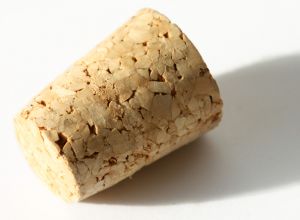 and is said to cost the wine industry hundreds of millions of dollars a year—although often it is the consumer of fine wines who is stuck, having opened a bottle 10, 20 or more years later after purchase. In this case, there is no redress, even if one has a receipt. And, since old wines are rarely purchased to be drunk immediately, even at auction, and expensive wines purchased new are generally not drinkable for years, hardly ever does one purchase an expensive wine to be drunk that week, i.e., so that if corked, it could be returned for a refund. Corticeira Amorim, the world’s largest producer of corks for wine bottles, saw sales decline each year and searched for a cure for the fungus. They developed a process that steams out the chemical compound TCA (chemical trichloroanisole) created by the fungus, which has helped lower the industry-wide incidence of cork taint to less than 1% of wine bottles produced, from as much as 5% (and spent an estimated €6 million a year in research on the project since 2000). Oeneo, a rival French cork producer, has developed its own taint-removal process that it claims has eliminated the problem caused by the fungus. Both companies, which lost money based on the migration away from cork, saw their share prices and earnings rise substantially based on the announcement; and the results have led some wine producers in South Africa and Chile—among the first to convert to screw caps—to start using cork again. Since it took a kick in the pocketbook to get these companies to fix their flawed product, let’s hope that consumers enjoy a permanent solution to the problem. About 78%, or 14 billion, of 18 billion wine bottles each year are closed with cork, down from about 95% 10 years ago. The number of “corked” is estimated to be as high as 12%. Vintners are hurt when consumers stop buying a brand after they have purchased a tainted bottle. and is said to cost the wine industry hundreds of millions of dollars a year—although often it is the consumer of fine wines who is stuck, having opened a bottle 10, 20 or more years later after purchase. In this case, there is no redress, even if one has a receipt. And, since old wines are rarely purchased to be drunk immediately, even at auction, and expensive wines purchased new are generally not drinkable for years, hardly ever does one purchase an expensive wine to be drunk that week, i.e., so that if corked, it could be returned for a refund. Corticeira Amorim, the world’s largest producer of corks for wine bottles, saw sales decline each year and searched for a cure for the fungus. They developed a process that steams out the chemical compound TCA (chemical trichloroanisole) created by the fungus, which has helped lower the industry-wide incidence of cork taint to less than 1% of wine bottles produced, from as much as 5% (and spent an estimated €6 million a year in research on the project since 2000). Oeneo, a rival French cork producer, has developed its own taint-removal process that it claims has eliminated the problem caused by the fungus. Both companies, which lost money based on the migration away from cork, saw their share prices and earnings rise substantially based on the announcement; and the results have led some wine producers in South Africa and Chile—among the first to convert to screw caps—to start using cork again. Since it took a kick in the pocketbook to get these companies to fix their flawed product, let’s hope that consumers enjoy a permanent solution to the problem. About 78%, or 14 billion, of 18 billion wine bottles each year are closed with cork, down from about 95% 10 years ago. The number of “corked” is estimated to be as high as 12%. Vintners are hurt when consumers stop buying a brand after they have purchased a tainted bottle.
FTC Challenges Whole Foods Acquisition of Wild Oats. The Federal Trade Commission has approved a complaint that challenges Whole Foods Market’s acquisition of its chief rival, Wild Oats Markets, valued at approximately $670 million. It has and authorized a temporary restraining order and preliminary injunction in federal 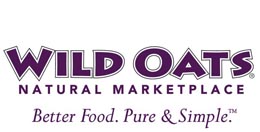 district court to halt the deal pending an administrative trial on the merits. According to the complaint, the transaction would violate federal antitrust laws by eliminating the substantial competition between these two uniquely close competitors in numerous markets nationwide in the operation of premium natural and organic supermarkets. If the transaction continues unopposed, the FTC contends that Whole Foods is likely to raise prices and reduce quality and services unilaterally. Whole Foods intends to challenge the FTC in court. Whole Foods Market opened its flagship London store last week, and plans to expand with 30 to 40 stores across Britain. The store, three floors of a former art deco department store in the affluent neighborhood of Kensington, is much larger than any existing grocery in Britain, and prices are expected to be even higher than those of England’s up-market leader, Waitrose. district court to halt the deal pending an administrative trial on the merits. According to the complaint, the transaction would violate federal antitrust laws by eliminating the substantial competition between these two uniquely close competitors in numerous markets nationwide in the operation of premium natural and organic supermarkets. If the transaction continues unopposed, the FTC contends that Whole Foods is likely to raise prices and reduce quality and services unilaterally. Whole Foods intends to challenge the FTC in court. Whole Foods Market opened its flagship London store last week, and plans to expand with 30 to 40 stores across Britain. The store, three floors of a former art deco department store in the affluent neighborhood of Kensington, is much larger than any existing grocery in Britain, and prices are expected to be even higher than those of England’s up-market leader, Waitrose.
Product Watch
Tamarillo: Coming To A Supermarket Near You? Tamarillo, a fruit resembling a 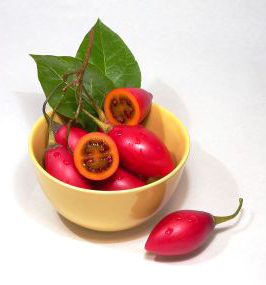 red, oversized plum, is native to South America, where it has long been used in sweet and savory dishes. It is a member of the same family as the eggplant, tomato and potato family, and was once known as the tree tomato until good marketers renamed it tamarillo in the 1960s. While it is an everyday food south of the border, in the U.S. outside of Latino supermarkets it is sold as an exotic fruit, and used in savory chutneys and sweet pies. Chef Shawn McClain of Chicago’s Spring restaurant serves a salad of tamarillo and fennel dressed with aged balsamic vinegar and Manuka honey. In addition to good taste, tamarillo is rich in beta carotene and vitamin E. Tamarillo season runs from now through the fall. Photo courtesy of Stock Xchng. red, oversized plum, is native to South America, where it has long been used in sweet and savory dishes. It is a member of the same family as the eggplant, tomato and potato family, and was once known as the tree tomato until good marketers renamed it tamarillo in the 1960s. While it is an everyday food south of the border, in the U.S. outside of Latino supermarkets it is sold as an exotic fruit, and used in savory chutneys and sweet pies. Chef Shawn McClain of Chicago’s Spring restaurant serves a salad of tamarillo and fennel dressed with aged balsamic vinegar and Manuka honey. In addition to good taste, tamarillo is rich in beta carotene and vitamin E. Tamarillo season runs from now through the fall. Photo courtesy of Stock Xchng.
Goose Island Flies Nationwide. If you see Goose Island beer, waddle on over and give it a try. The craft beer, made in Chicago, was in limited states prior to a recent distribution deal with Widmer Brothers Brewing Company, part of the Anheuser-Busch beer distribution network. The beer is a favorite of one of THE NIBBLE’s Chicago-based editors. Goose Island’s 312 Urban Wheat unfiltered ale (312 is Chicago’s area code) was a 2006 Great American Beer Festival gold medal winner, and surpassed the company’s Honker's Ale as its best-selling beer.
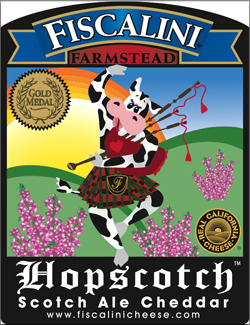 Fiscalini’s New Cheddar. One of our favorite artisan cheesemakers announces a bonnie new cheddar: a wonderfully savory Scotch ale Cheddar named Hopscotch. The label shows a happy Holstein dressed as a bagpiper in Heather Fiscalini’s Kerr family tartan. Hopscotch will be available in stores (including Fiscalini’s online store) shortly. Fiscalini’s 18-month Bandage Wrapped Cheddar just won top honors at London’s World Cheese Awards—a very special honor for an American Cheddar to beat the English Cheddars when judged by English jurors on their own turf. Be sure to order some when you’re trying Hopscotch. Read our full review of Fiscalini cheeses. Fiscalini’s New Cheddar. One of our favorite artisan cheesemakers announces a bonnie new cheddar: a wonderfully savory Scotch ale Cheddar named Hopscotch. The label shows a happy Holstein dressed as a bagpiper in Heather Fiscalini’s Kerr family tartan. Hopscotch will be available in stores (including Fiscalini’s online store) shortly. Fiscalini’s 18-month Bandage Wrapped Cheddar just won top honors at London’s World Cheese Awards—a very special honor for an American Cheddar to beat the English Cheddars when judged by English jurors on their own turf. Be sure to order some when you’re trying Hopscotch. Read our full review of Fiscalini cheeses.
Trends
Chocolate Cafés. It’s still a trickle, but sure as every town has its Starbucks, it will have its chocolate café. You can’t open a paper without hearing of another venture.
- First there was Ethel’s Chocolate Lounge in Chicago’s Lincoln Park neighborhood, which expanded to multiple locations.
- Portland, Oregon’s Moonstruck Café, an extension of Moonstruck Chocolates, has announced plans to open expand in the Midwest and on the East Coast, for a total of 17 cafés by 2009.
- Last week Bissinger’s, St. Louis’s destination chocolate store, launched its chocolate lounge, Bissinger’s: A Chocolate Experience with chocolates plus homemade desserts and small-batch chocolates that aren’t available in its five chocolate stores. There’s a chocolate sommelier to take you through “flights” of chocolate and compatible wines, liqueurs, coffees and coffee drinks, tea and chocolate milk (of course!).
- Perhaps the greatest chocolate café of all is the Michel Cluizel Salon in New York City, featuring the chocolates of the great French chocolatier, chocolate sommeliers and a variety of tastings, with or without paired wines and liquors. (We’ve tasted it all, and it remains one of the most memorable tasting experiences in our life. Read our review of Michel Cluizel and the Michel Cluizel Chocolate Salon.)
While mom and pop chocolate shops frequently append a café to their counters, and retail chains like Godiva shops have had in-store café ventures, the chocolate café as a 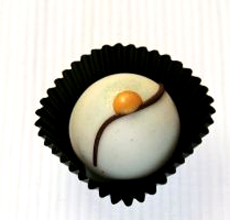 business is growing. No doubt, some entrepreneurs hope to become the Starbucks of chocolate cafés—something Starbucks itself can’t do without diluting its coffee franchise, although it does offer a chocolate beverage and assorted chocolate items like chocolate-covered coffee beans. The chocolate café cafe is hardly a new notion: It dates back to 17th-century London, about a century after cocoa was brought from the Aztecs to Spain by the conquistadors. Like coffee houses of the time, the well-to-do socialized while drinking hot chocolate. There were no candies or chocolate desserts, though—hard chocolate, or “chocolate for eating,” as it was called, was not invented until 1847. business is growing. No doubt, some entrepreneurs hope to become the Starbucks of chocolate cafés—something Starbucks itself can’t do without diluting its coffee franchise, although it does offer a chocolate beverage and assorted chocolate items like chocolate-covered coffee beans. The chocolate café cafe is hardly a new notion: It dates back to 17th-century London, about a century after cocoa was brought from the Aztecs to Spain by the conquistadors. Like coffee houses of the time, the well-to-do socialized while drinking hot chocolate. There were no candies or chocolate desserts, though—hard chocolate, or “chocolate for eating,” as it was called, was not invented until 1847.
Own A Wine Store. Want to be in the luxury food and wine business? Ride the trend and own a wine store that caters to everyday bottlings for everyday dinners. The New York Times reports that a recent list of fast-growing franchises included both Vino 100 and WineStyles. Both businesses aim to offer value wines—relatively low-priced bottles that can be drunk immediately—presented to consumers in a unpretentious and demystified manner. The shops are also used for events and socializing.

6.4.07
News
More Benefits From Olive Oil. It’s old news that olive oil is heart healthy. The science is so overwhelming that the FDA allows a health claim on bottles linking olive oil to reduced risk of coronary heart disease. Now, it seems that olive oil is more than just heart healthy. As reported in the journal Nature, scientists from the Monell Chemical Research Center in Philadelphia have discovered that olive oil contains a compound that has the same molecular action as the painkiller ibuprofen, which means that olive oil may offer the same anti-inflammatory properties as well as some of ibuprofen’s other benefits, which include a reduced risk of heart attack, stroke, certain cancers and Alzheimer’s disease. In addition, researchers at Northwestern University’s Feinberg Medical School conducted laboratory experiments on breast-cancer cells that showed that the monounsaturated fat oleic acid, found in olive oil, dramatically cuts the levels of a cancer-promoting gene called Her-2/neu while boosting the effectiveness of treatment. See our Oil & Vinegar Section for more information about olive oil.
Organic Food Growth Creates Issues. Summarizing what many have been saying for several years, a Canadian researcher notes that organic food, taken over by big business, has become an assembly-line product marketed as “yuppie chow.” As reported in The Globe and Mail in Toronto, Irena Knezevic of Toronto’s York University presented a study to social science scholars on Friday showing that multinational food-processing giants such as ConAgra Foods, Cargill, Kraft Foods, Coca-Cola and PepsiCo now own most significant organic brands.* While the food may meet organic standards, it is prepared, packaged, shipped and marketed in ways that are anathema to organic agriculture’s essence, which includes environmentalism. The food giants, Knezevic said, have simply applied conventional-food mass-production techniques to organic foods, producing “environmental consequences comparable to those of conventional-food production.” Such assertions parallel complaints by U.S. watch groups, that huge corporations such as Dean Foods, which owns the Horizon organic dairy brand, do not observe the letter of the organic law. Allegations in the case of Horizon include that their huge herds are not able to graze on pasture daily, an organic requirement; only that there is theoretical “access to pasture.” To quote a small producer published in the trade column, The Morning Cup: “There are many of us in this business who play by the rules. The products we make meet all the standards of true organically-produced food. We skip no corners, we do it right.” And there are industry specialists who have told us that, e.g., there is more organic chocolate being sold than there is currently grown. When Wal-Mart announced its intention to sell organics, the industry shuddered, knowing that in an attempt to supply the giant with the requisite amount of product, the organic standards were likely to slip. We’re certain to hear more of this on an ongoing basis.
*Some examples include:Anheuser-Busch (Wild Hop, Stone Mill), Cadbury Schweppes (Green & Black’s organic chocolate, Nantucket Nectars), Coca-Cola (Odwalla), Danone (Stonyfield Farm), Dean Foods (Alta Dena, Horizon, The Organic Cow of Vermont), General Mills (Cascadian Farms, Muir Glenn), J.M. Smucker (After The Fall, Knudsen’s), Kellog (Kashi, Morningstar Farms/Natural Touch), Kraft (Back to Nature, Boca Foods), PepsiCo (Naked Juice, Izze Beverages, Stacy’s Pita Chips), Hershey’s (Dagoba Chocolate, Joseph Schmidt and Scharffenberger Chocolate), Mars/Masterfoods (Seeds Of Change Organic Foods), Starbucks (Tazo Tea), Tyson (Nature’s Farm).
Product Watch
Winning Potato Chip Arrives. We barely noticed the Miss Universe Pageant: To us, the competition news is that the winner of the third annual People’s Choice campaign has arrived in natural food and grocery stores nationwide. This year, fans chose exotic Island Jerk as the new Kettle brand potato chip flavor—a zesty flavor with 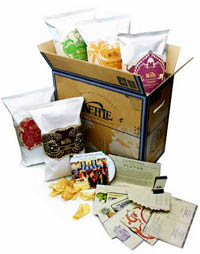 a smoky-sweet complexity that combines chile pepper, black pepper, cinnamon, allspice, cumin and thyme. Island Jerk joins prior People’s Choice winners: Buffalo Bleu, Cheddar Beer, Spicy Thai and Tuscan Three Cheese. The chips are available in five-ounce bags, for $1.99 to $2.29. Each year, Kettle brand develops five exciting chip flavors and invites chip lovers to vote online. While many people vote based on the concept, thousands send for the tasting kit—full-size bags of the flavors along with all the materials needed to hold a chip tasting party (shown in the photo at right). This year, the theme was international: Aztec Chocolate (featuring Dagoba Organic Chocolate), Dragon 5 Spice, Island Jerk, Royal Indian Curry and Twisted Chili Lime. We loved them all, but agreed with the majority that Island Jerk had the broadest application—i.e., while all the flavors were delicious snacks-from-the-bag, Island Jerk pairs best with burgers, sandwiches, soup and other foods. In fact, they add a lot of pizzazz to everyday foods—reason enough to run out and buy a bag! a smoky-sweet complexity that combines chile pepper, black pepper, cinnamon, allspice, cumin and thyme. Island Jerk joins prior People’s Choice winners: Buffalo Bleu, Cheddar Beer, Spicy Thai and Tuscan Three Cheese. The chips are available in five-ounce bags, for $1.99 to $2.29. Each year, Kettle brand develops five exciting chip flavors and invites chip lovers to vote online. While many people vote based on the concept, thousands send for the tasting kit—full-size bags of the flavors along with all the materials needed to hold a chip tasting party (shown in the photo at right). This year, the theme was international: Aztec Chocolate (featuring Dagoba Organic Chocolate), Dragon 5 Spice, Island Jerk, Royal Indian Curry and Twisted Chili Lime. We loved them all, but agreed with the majority that Island Jerk had the broadest application—i.e., while all the flavors were delicious snacks-from-the-bag, Island Jerk pairs best with burgers, sandwiches, soup and other foods. In fact, they add a lot of pizzazz to everyday foods—reason enough to run out and buy a bag!
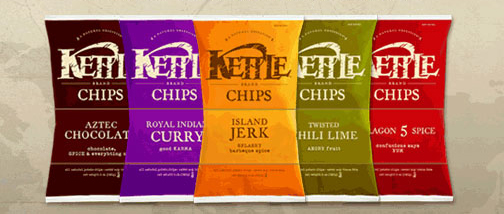
The 2007 Kettle brand chip contestants flank the winner (in center), Island Jerk.
Food Travel
Weekend Barbecue. If you love New York, barbecue and glam hotels, come to the Big Apple from June 8th-10th for Union Square and Danny Meyer’s 5th Annual Big Apple Barbecue Block Party. Barbecue gastronomes who are guests at the W New York—Union Square hotel will have an easier time nibbling their way through this popular event thanks to a Bubba FastPass, which delivers exclusive access to express lines for all food and beverage purveyors. The barbecue festival celebrates America’s culinary and music traditions: fiery barbecue pits from the nation’s top pit masters, live jazz, blues, bluegrass, barbecue experts, beverages, demonstrations and a barbecue film. The package, priced at $489 to $569 per night double occupancy, is for arrivals June 8-10th. Bubba FastPasses are valid only at The 5th Annual Big Apple Block Party June 9–10, 2007. For more information, contact StarwoodHotels.com.show.

News Archives
| 3rd Quarter 2007 |
|
|
|
|
|
| 1st Quarter 2007 |
4th Quarter 2006 |
3rd Quarter 2006 |
|
|
|
| 2nd Quarter 2006 |
1st Quarter 2006 |
4th Quarter 2005 |
|
|
|
| 3rd Quarter 2005 |
2nd Quarter 2005 |
1st Quarter 2005 |
|
|
|
Send your product news to:
Info at TheNibble. com.
Substitute @ for <at> and use TheNibble.com with no space. We use this convention to avoid address-harvesting spam spiders.
Don’t Miss The News:
Subscribe To Our Gourmet News & Views News Feed
Lifestyle Direct Direct, Inc. All rights reserved. Images are the copyright of their respective owners.

|






 could no longer boast the “Appellation d’Origine Contrôlée” or “A.O.C.,” an official (and highly-coveted) certification that authenticates the content, origin and method of production of a French agricultural item. As a result, both companies lost their A.O.C. status, but are petitioning for its return. They claim that treating the milk—by either filtering or gently heating it—does not diminish the taste nor the quality of the cheese, and therefore they should still be granted A.O.C. status, claiming that they switched processes due to health concerns (there are occasional cases of illness and rare instances of death from the bacteria in raw milk cheese). Some would beg to differ, including the recently-formed Committee for the Defense of Authentic Camembert, a small lobbying group created to defend the use of raw milk when creating Camembert cheese. It claims that the move is a ploy by the dairy giants to make more cheese and more profit while destroying a part of French gastronomic heritage. If the companies’ petition is granted, they argue, raw milk cheese would be threatened. Out of the 112,000 tons of Camembert produced in France, only 12,000 of those tons (made from raw milk from Normandy) were granted A.O.C. status. Cheesemakers and connoisseurs prefer raw milk because the heat that destroys potentially harmful bacteria also destroys beneficial bacteria that add delicate flavor to the cheese. The raw milk vs. pasteurized milk debate exists in the U.S. as well. The USDA is extremely protective of U.S. citizens, prohibiting the sale of raw milk cheeses until they have been aged for at least 60 days, by which time any harmful bacteria will have expired. Read our article on the great
could no longer boast the “Appellation d’Origine Contrôlée” or “A.O.C.,” an official (and highly-coveted) certification that authenticates the content, origin and method of production of a French agricultural item. As a result, both companies lost their A.O.C. status, but are petitioning for its return. They claim that treating the milk—by either filtering or gently heating it—does not diminish the taste nor the quality of the cheese, and therefore they should still be granted A.O.C. status, claiming that they switched processes due to health concerns (there are occasional cases of illness and rare instances of death from the bacteria in raw milk cheese). Some would beg to differ, including the recently-formed Committee for the Defense of Authentic Camembert, a small lobbying group created to defend the use of raw milk when creating Camembert cheese. It claims that the move is a ploy by the dairy giants to make more cheese and more profit while destroying a part of French gastronomic heritage. If the companies’ petition is granted, they argue, raw milk cheese would be threatened. Out of the 112,000 tons of Camembert produced in France, only 12,000 of those tons (made from raw milk from Normandy) were granted A.O.C. status. Cheesemakers and connoisseurs prefer raw milk because the heat that destroys potentially harmful bacteria also destroys beneficial bacteria that add delicate flavor to the cheese. The raw milk vs. pasteurized milk debate exists in the U.S. as well. The USDA is extremely protective of U.S. citizens, prohibiting the sale of raw milk cheeses until they have been aged for at least 60 days, by which time any harmful bacteria will have expired. Read our article on the great  outside on a grill. The winning foods were presented at a grill-off in New York City’s Riverside Park, pairing each of the finalists with a Redwood Creek wine. Judges, including the Food Network’s Bob Blumer, tasted Chincoteague Scallops, Coal-Roasted Chuckbox Pozole-Stuffed Onions, Down East Lobster Scampi à la Campfire, Lost in the Woods Pork Tenderloin and Rocky Mountain Pinon Paella. The winner—also THE NIBBLE editors’ favorite, were the Coal-Roasted Chuckbox Pozole-Stuffed Onions, by Leah Lyon, Ada, Oklahoma. Look for the recipes on the RedwoodCreek.com website.
outside on a grill. The winning foods were presented at a grill-off in New York City’s Riverside Park, pairing each of the finalists with a Redwood Creek wine. Judges, including the Food Network’s Bob Blumer, tasted Chincoteague Scallops, Coal-Roasted Chuckbox Pozole-Stuffed Onions, Down East Lobster Scampi à la Campfire, Lost in the Woods Pork Tenderloin and Rocky Mountain Pinon Paella. The winner—also THE NIBBLE editors’ favorite, were the Coal-Roasted Chuckbox Pozole-Stuffed Onions, by Leah Lyon, Ada, Oklahoma. Look for the recipes on the RedwoodCreek.com website. 
 of blood diamonds, but now there is another problem product infiltrating commercial markets: blood chocolate. According to the appropriately dubbed “Hot Chocolate” report released by U.K.-based watch group Global Witness, more than $118 million of the cocoa (cacao) trade has been used to fund both the Côte d’Ivoire government and Forces Nouvelles, the rebel group holding onto the northern part of the Côte d’Ivoire. Forty percent of the world’s cacao comes from the Ivory Coast, making the county the world’s largest supplier of chocolate. Ghana, the next largest producer, supplies only 20%. Out of a total population of 16 million, three to four million people work in the cacao industry. None of the Côte d’Ivoire cacao is fair-trade or organic. To understand this complex issue in depth, read the report, which can be downloaded from GlobalWitness.org.
of blood diamonds, but now there is another problem product infiltrating commercial markets: blood chocolate. According to the appropriately dubbed “Hot Chocolate” report released by U.K.-based watch group Global Witness, more than $118 million of the cocoa (cacao) trade has been used to fund both the Côte d’Ivoire government and Forces Nouvelles, the rebel group holding onto the northern part of the Côte d’Ivoire. Forty percent of the world’s cacao comes from the Ivory Coast, making the county the world’s largest supplier of chocolate. Ghana, the next largest producer, supplies only 20%. Out of a total population of 16 million, three to four million people work in the cacao industry. None of the Côte d’Ivoire cacao is fair-trade or organic. To understand this complex issue in depth, read the report, which can be downloaded from GlobalWitness.org.  New York, Miami, and Chicago. Vida is recognized as ultra-premium due to the distillation process used to removed heads, the slightly metallic tasting compound common in other tequila brands, and tails, the final part of the distillation process that removes ethanol which often causes hangovers. Thus, only the “heart” of the blue agave, the most flavorful part of the plant, remains. Vida has three kinds of tequila available:
New York, Miami, and Chicago. Vida is recognized as ultra-premium due to the distillation process used to removed heads, the slightly metallic tasting compound common in other tequila brands, and tails, the final part of the distillation process that removes ethanol which often causes hangovers. Thus, only the “heart” of the blue agave, the most flavorful part of the plant, remains. Vida has three kinds of tequila available:
 who suggested the holiday back in 1909. Her father, Civil War veteran William Smart, was a widower who raised six children. As an adult, Mrs. Dodd wanted to honor the selflessness of her father and others, and proposed June 5, her father’s birthday. However, the celebration was postponed until the third Sunday in June, to have time to prepare Father’s Day cards. From the grass roots movement in Washington, various towns and cities across America began to celebrate a Father’s Day. In 1924, President Calvin Coolidge supported the idea of a national holiday, but it didn’t become official until 1966, when President Lyndon Johnson signed a presidential proclamation that set aside the third Sunday of June as Father’s Day. Buy dad a deluxe chocolate cigar from BurdickChocolate.com, or pick one up at your nearest Godiva boutique.
who suggested the holiday back in 1909. Her father, Civil War veteran William Smart, was a widower who raised six children. As an adult, Mrs. Dodd wanted to honor the selflessness of her father and others, and proposed June 5, her father’s birthday. However, the celebration was postponed until the third Sunday in June, to have time to prepare Father’s Day cards. From the grass roots movement in Washington, various towns and cities across America began to celebrate a Father’s Day. In 1924, President Calvin Coolidge supported the idea of a national holiday, but it didn’t become official until 1966, when President Lyndon Johnson signed a presidential proclamation that set aside the third Sunday of June as Father’s Day. Buy dad a deluxe chocolate cigar from BurdickChocolate.com, or pick one up at your nearest Godiva boutique. and is said to cost the wine industry hundreds of millions of dollars a year—although often it is the consumer of fine wines who is stuck, having opened a bottle 10, 20 or more years later after purchase. In this case, there is no redress, even if one has a receipt. And, since old wines are rarely purchased to be drunk immediately, even at auction, and expensive wines purchased new are generally not drinkable for years, hardly ever does one purchase an expensive wine to be drunk that week, i.e., so that if corked, it could be returned for a refund. Corticeira Amorim, the world’s largest producer of corks for wine bottles, saw sales decline each year and searched for a cure for the fungus. They developed a process that steams out the chemical compound TCA (chemical trichloroanisole) created by the fungus, which has helped lower the industry-wide incidence of cork taint to less than 1% of wine bottles produced, from as much as 5% (and spent an estimated €6 million a year in research on the project since 2000). Oeneo, a rival French cork producer, has developed its own taint-removal process that it claims has eliminated the problem caused by the fungus. Both companies, which lost money based on the migration away from cork, saw their share prices and earnings rise substantially based on the announcement; and the results have led some wine producers in South Africa and Chile—among the first to convert to screw caps—to start using cork again. Since it took a kick in the pocketbook to get these companies to fix their flawed product, let’s hope that consumers enjoy a permanent solution to the problem. About 78%, or 14 billion, of 18 billion wine bottles each year are closed with cork, down from about 95% 10 years ago. The number of “corked” is estimated to be as high as 12%. Vintners are hurt when consumers stop buying a brand after they have purchased a tainted bottle.
and is said to cost the wine industry hundreds of millions of dollars a year—although often it is the consumer of fine wines who is stuck, having opened a bottle 10, 20 or more years later after purchase. In this case, there is no redress, even if one has a receipt. And, since old wines are rarely purchased to be drunk immediately, even at auction, and expensive wines purchased new are generally not drinkable for years, hardly ever does one purchase an expensive wine to be drunk that week, i.e., so that if corked, it could be returned for a refund. Corticeira Amorim, the world’s largest producer of corks for wine bottles, saw sales decline each year and searched for a cure for the fungus. They developed a process that steams out the chemical compound TCA (chemical trichloroanisole) created by the fungus, which has helped lower the industry-wide incidence of cork taint to less than 1% of wine bottles produced, from as much as 5% (and spent an estimated €6 million a year in research on the project since 2000). Oeneo, a rival French cork producer, has developed its own taint-removal process that it claims has eliminated the problem caused by the fungus. Both companies, which lost money based on the migration away from cork, saw their share prices and earnings rise substantially based on the announcement; and the results have led some wine producers in South Africa and Chile—among the first to convert to screw caps—to start using cork again. Since it took a kick in the pocketbook to get these companies to fix their flawed product, let’s hope that consumers enjoy a permanent solution to the problem. About 78%, or 14 billion, of 18 billion wine bottles each year are closed with cork, down from about 95% 10 years ago. The number of “corked” is estimated to be as high as 12%. Vintners are hurt when consumers stop buying a brand after they have purchased a tainted bottle. district court to halt the deal pending an administrative trial on the merits. According to the complaint, the transaction would violate federal antitrust laws by eliminating the substantial competition between these two uniquely close competitors in numerous markets nationwide in the operation of premium natural and organic supermarkets. If the transaction continues unopposed, the FTC contends that Whole Foods is likely to raise prices and reduce quality and services unilaterally. Whole Foods intends to challenge the FTC in court. Whole Foods Market opened its flagship London store last week, and plans to expand with 30 to 40 stores across Britain. The store, three floors of a former art deco department store in the affluent neighborhood of Kensington, is much larger than any existing grocery in Britain, and prices are expected to be even higher than those of England’s up-market leader, Waitrose.
district court to halt the deal pending an administrative trial on the merits. According to the complaint, the transaction would violate federal antitrust laws by eliminating the substantial competition between these two uniquely close competitors in numerous markets nationwide in the operation of premium natural and organic supermarkets. If the transaction continues unopposed, the FTC contends that Whole Foods is likely to raise prices and reduce quality and services unilaterally. Whole Foods intends to challenge the FTC in court. Whole Foods Market opened its flagship London store last week, and plans to expand with 30 to 40 stores across Britain. The store, three floors of a former art deco department store in the affluent neighborhood of Kensington, is much larger than any existing grocery in Britain, and prices are expected to be even higher than those of England’s up-market leader, Waitrose. red, oversized plum, is native to South America, where it has long been used in sweet and savory dishes. It is a member of the same family as the eggplant, tomato and potato family, and was once known as the tree tomato until good marketers renamed it tamarillo in the 1960s. While it is an everyday food south of the border, in the U.S. outside of Latino supermarkets it is sold as an exotic fruit, and used in savory chutneys and sweet pies. Chef Shawn McClain of Chicago’s Spring restaurant serves a salad of tamarillo and fennel dressed with aged balsamic vinegar and Manuka honey. In addition to good taste, tamarillo is rich in beta carotene and vitamin E. Tamarillo season runs from now through the fall.
red, oversized plum, is native to South America, where it has long been used in sweet and savory dishes. It is a member of the same family as the eggplant, tomato and potato family, and was once known as the tree tomato until good marketers renamed it tamarillo in the 1960s. While it is an everyday food south of the border, in the U.S. outside of Latino supermarkets it is sold as an exotic fruit, and used in savory chutneys and sweet pies. Chef Shawn McClain of Chicago’s Spring restaurant serves a salad of tamarillo and fennel dressed with aged balsamic vinegar and Manuka honey. In addition to good taste, tamarillo is rich in beta carotene and vitamin E. Tamarillo season runs from now through the fall.  Fiscalini’s New Cheddar.
Fiscalini’s New Cheddar. business is growing. No doubt, some entrepreneurs hope to become the Starbucks of chocolate cafés—something Starbucks itself can’t do without diluting its coffee franchise, although it does offer a chocolate beverage and assorted chocolate items like chocolate-covered coffee beans. The chocolate café cafe is hardly a new notion: It dates back to 17th-century London, about a century after cocoa was brought from the Aztecs to Spain by the conquistadors. Like coffee houses of the time, the well-to-do socialized while drinking hot chocolate. There were no candies or chocolate desserts, though—hard chocolate, or “chocolate for eating,” as it was called, was not invented until 1847.
business is growing. No doubt, some entrepreneurs hope to become the Starbucks of chocolate cafés—something Starbucks itself can’t do without diluting its coffee franchise, although it does offer a chocolate beverage and assorted chocolate items like chocolate-covered coffee beans. The chocolate café cafe is hardly a new notion: It dates back to 17th-century London, about a century after cocoa was brought from the Aztecs to Spain by the conquistadors. Like coffee houses of the time, the well-to-do socialized while drinking hot chocolate. There were no candies or chocolate desserts, though—hard chocolate, or “chocolate for eating,” as it was called, was not invented until 1847.
 a smoky-sweet complexity that combines chile pepper, black pepper, cinnamon, allspice, cumin and thyme. Island Jerk joins prior People’s Choice winners: Buffalo Bleu, Cheddar Beer, Spicy Thai and Tuscan Three Cheese. The chips are available in five-ounce bags, for $1.99 to $2.29. Each year, Kettle brand develops five exciting chip flavors and invites chip lovers to vote online. While many people vote based on the concept, thousands send for the tasting kit—full-size bags of the flavors along with all the materials needed to hold a chip tasting party (shown in the photo at right). This year, the theme was international: Aztec Chocolate (featuring Dagoba Organic Chocolate), Dragon 5 Spice, Island Jerk, Royal Indian Curry and Twisted Chili Lime. We loved them all, but agreed with the majority that Island Jerk had the broadest application—i.e., while all the flavors were delicious snacks-from-the-bag, Island Jerk pairs best with burgers, sandwiches, soup and other foods. In fact, they add a lot of pizzazz to everyday foods—reason enough to run out and buy a bag!
a smoky-sweet complexity that combines chile pepper, black pepper, cinnamon, allspice, cumin and thyme. Island Jerk joins prior People’s Choice winners: Buffalo Bleu, Cheddar Beer, Spicy Thai and Tuscan Three Cheese. The chips are available in five-ounce bags, for $1.99 to $2.29. Each year, Kettle brand develops five exciting chip flavors and invites chip lovers to vote online. While many people vote based on the concept, thousands send for the tasting kit—full-size bags of the flavors along with all the materials needed to hold a chip tasting party (shown in the photo at right). This year, the theme was international: Aztec Chocolate (featuring Dagoba Organic Chocolate), Dragon 5 Spice, Island Jerk, Royal Indian Curry and Twisted Chili Lime. We loved them all, but agreed with the majority that Island Jerk had the broadest application—i.e., while all the flavors were delicious snacks-from-the-bag, Island Jerk pairs best with burgers, sandwiches, soup and other foods. In fact, they add a lot of pizzazz to everyday foods—reason enough to run out and buy a bag!
